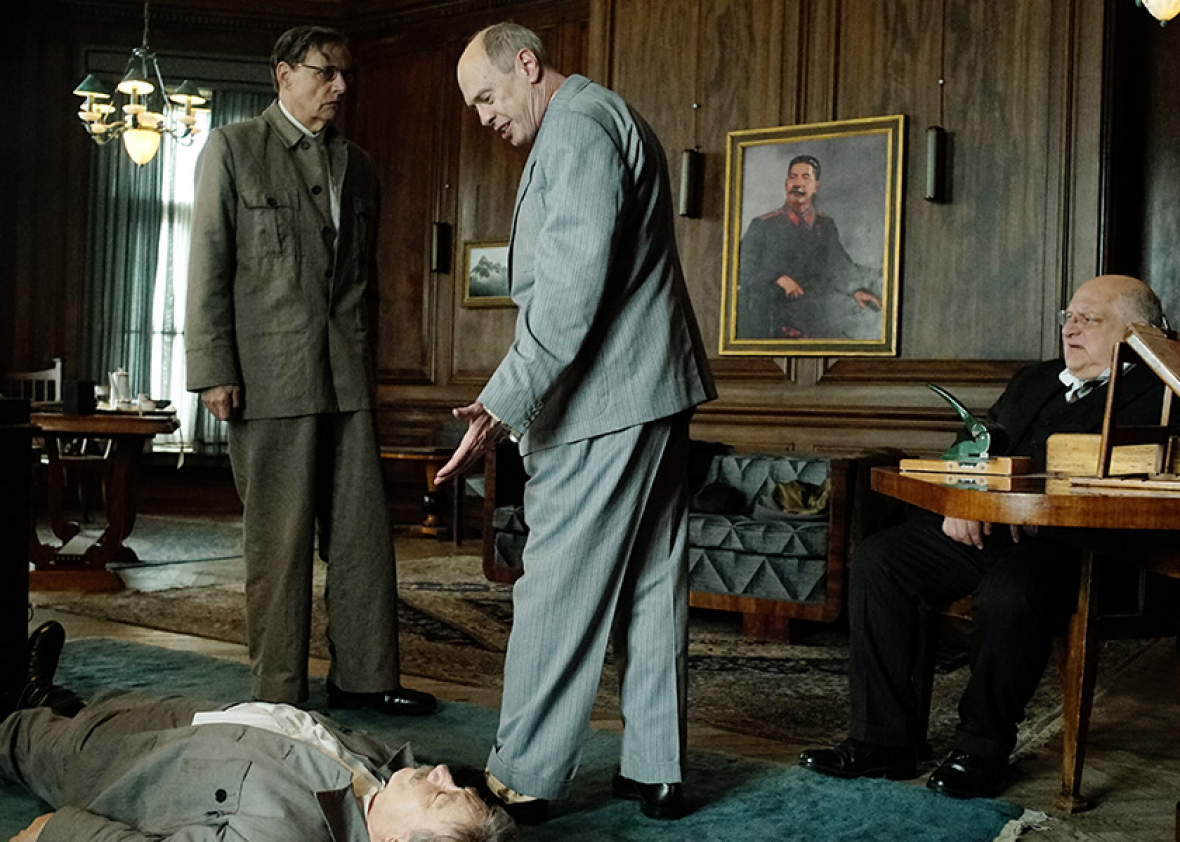Armando Iannucci doesn’t tell stories about the exercise of power so much as the futile squabbling for it. On Veep and its U.K. forerunner, The Thick of It, the president and the Prime Minister are kept judiciously out of frame as he focuses on the lesser officials trying to sway their actions or avoid their wrath. That phenomenon isn’t unique to the political realm—Alan Partridge, who Iannucci created with Steve Coogan, is a moderately (and then steadily less) famous TV presenter whose egotism is no less monstrous for the piddling influence he actually wields—but in politics, the perpetual scrum is rendered both more grotesque and more tragic by the higher calling to which his characters are perpetually deaf.
The underlying joke of both The Thick of It and Veep is that for all the high stakes of contemporary geopolitical maneuvering, nothing that the shows’ characters do ever makes much of a difference; even in the Oval Office, Veep’s Selina Meyer seemed unable to get anything done. But on the big screen the consequences are far more dire. In In the Loop, a minor gaffe by a tongue-tied official leads the United States into a war that no one actually seems to want. And in The Death of Stalin, which had its world premiere at the Toronto International Film Festival on Friday, the Soviet leader’s expiration creates a political vacuum which is promptly filled with corpses. (A theatrical release from IFC Films is scheduled for January.) It’s a rapid-fire farce punctuated by gunshots and the sound of bodies hitting the floor.
Like the graphic novel on which it is based, The Death of Stalin opens with a sequence that combines comedy and terror. (Before the screening, Iannucci explained that he wanted the audience to laugh, but also to be “slightly nervous.”) Midway through a live concerto broadcast, a Moscow orchestra gets the call that Stalin himself would like a recording of the performance. Just one problem—no one was recording it. So the players must be held over and the concerto replayed, with audience members who’d already departed replaced by ragged peasants pulled in off the street so the hall’s acoustics won’t be changed. One of the frenzied broadcasters wonders aloud if such elaborate precautions are really necessary, but his colleague, mindful the studio may be bugged, nervously rebuts him: Of course Comrade Stalin, with his perfect ear—two of them, even—would notice the difference.
The sequence is pure slapstick—one complication occurs when the panicked orchestra conductor accidentally knocks himself unconscious and has to be replaced—but it’s undergirded by the notion that failure could mean the gulag, or death. (Iannucci underlines the threat by intercutting the orchestra hall with shots of Muscovites being pulled from their beds by the NKVD, presumably never to be seen again.) The movie, which Iannucci wrote with regular collaborators David Schneider, Ian Martin, and Peter Fellows, thrives on that back-and-forth, never leaning too hard into the atrocities committed under and after Stalin, but never letting us forget them, either. As part of that opening sequence, we see NKVD head Lavrentiy Beria (Simon Russell Beale) issuing lists of people to be executed, some in particularly gruesome and cruel ways, but there’s no menace in his voice; making sure a man sees his children killed before he is shot himself is simply all in a day’s work.
Stalin’s stroke sends his terrified but ambitious subordinates into a frenzy; he lies on the floor of his office for hours as they argue over what to do next, the difficulty of their decision compounded by the fact that all of Moscow’s best doctors have been executed as potential traitors. (Like many of the movie’s most absurd details, that one is based in truth.) One after another, they kneel to inspect his body, and one after another springs up with his trousers dampened by the piss-soaked rug beneath. The comedy is tragic and terrible, or it would be if the movie gave us time to catch our breath.
The killing worsens as it becomes clear that Stalin will not recover, but Iannucci keeps it largely off-screen until a pivotal moment in the final minutes. During the Q&A after the screening, he explained that he had shot more graphic footage for the earlier scenes but removed it all in editing, although the effect is merely to dampen the horror rather than excise it. It’s as if you’re watching two movies play out on top of each other, one about a group of vain, ridiculous men fighting over status and consumed by trivial tasks. (At one point, Steve Buscemi’s Khrushchev is preoccupied with the question of whether or not the curtains at Stalin’s funeral should be ruched.) Around the edges of that one is another, darker, movie about the people who are tortured and killed on their whims, with no recourse to the law or even common sense.
The Death of Stalin was conceived well before the last U.S. election, and Iannucci has said that he “finds it difficult to be funny” about Donald Trump. But in attempting to step away from American politics after Veep, Iannucci found himself inadvertently making a movie about, as he put it, “a delusional narcissist who’s terrifying his country.” It’s a story about the way authoritarian rule corrodes the political infrastructure of a nation, and how the removal of a tyrant can breed chaos that is every bit as dangerous as—and significantly more unpredictable than—his rule. As much as many Americans may wish for Trump’s removal, The Death of Stalin is a reminder to be careful what you wish for, and to be just as wary of what might come next.
